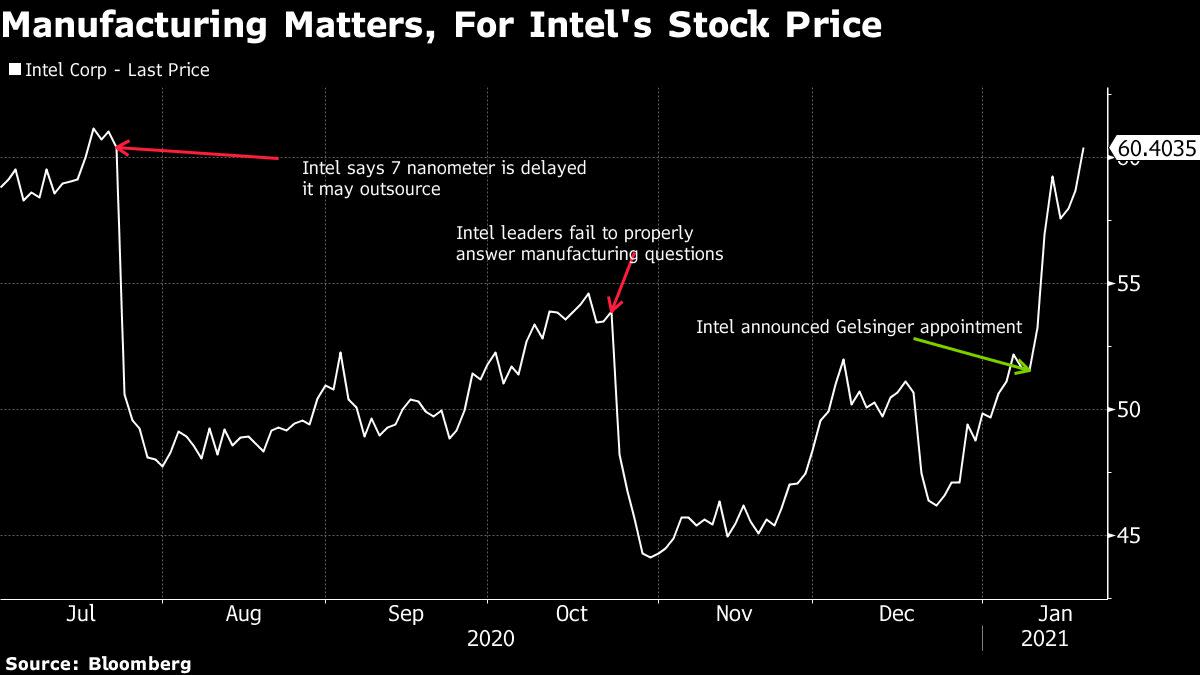Intel’s New CEO Commits to Manufacturing, Sending Shares Lower

(Bloomberg) — Intel Corp.’s incoming Chief Executive Officer Pat Gelsinger pledged to regain the company’s lead in chip manufacturing, countering growing calls from some investors to shed that part of its business.
“I am confident that the majority of our 2023 products will be manufactured internally,” he said. “At the same time, given the breadth of our portfolio, it’s likely that we will expand our use of external foundries for certain technologies and products.”
He plans to provide more details after officially taking over the CEO role Feb. 15, however Gelsinger was clear that Intel is sticking with its once-mighty manufacturing operation.
“We’re not just interested in closing gaps,” he told analysts on a conference call Thursday. “We’re interested in resuming that position as the unquestioned leader in process technology.”
This won’t happen overnight and some investors doubt Intel can catch up. Meanwhile, competitors will be able to take advantage of better production for at least a couple of years. Activist Dan Loeb has been calling for the company to spin off its manufacturing business. Other investors have been waiting to see if Intel will outsource more production. Intel shares fell almost 5% in extended trading.
Gelsinger is taking the reins of a company in the midst of its worst crisis in at least a decade. It has been the largest chipmaker for most of the past 30 years, dominating the $400 billion industry by making the best designs in its own cutting-edge factories. Most other U.S. chip companies shut or sold plants and tapped other firms to make the components. Intel held out, arguing that doing both improved each side of its operations and created better semiconductors.
That strategy has crumbled in recent years as Intel struggled to introduce new production techniques on time. It is now lagging behind Taiwan Semiconductor Manufacturing Co. and Samsung Electronics Co., which make chips for Intel competitors, such as Advanced Micro Devices Inc., and big Intel customers including Amazon.com Inc. and Apple Inc.
AMD shares rallied in extended trading while Gelsinger discussed his goal of improving Intel’s in-house manufacturing.
Intel’s quarterly results, released before the market closed on Thursday, sent the shares higher in New York earlier on Thursday. A hacker accessed sensitive information from Intel’s website, prompting the company to report the numbers earlier than planned.
Revenue in the period ending in March will be about $17.5 billion, the Santa Clara, California-based company said. This excludes the memory chip division Intel is selling. Analysts were looking for $16.2 billion on average, according to data compiled by Bloomberg.
Intel sees strong demand for laptops through the first half of the year, Chief Financial Officer George Davis said in an interview. Earnings in the second part of the year will partly depend on whether corporations increase spending on new hardware, he added.
“The question is will we see support from enterprise,” he said. “They’ve been very quiet.”
Intel’s personal computer chip division had revenue of $10.9 billion in the fourth quarter. Analysts expected $9.72 billion. Its higher-margin data center unit generated sales of $6.1 billion. Wall Street was looking for $5.37 billion.
In Intel’s data center business, revenue from cloud service providers fell 15% from a year earlier. Enterprise and government sales slumped 25%. Volumes and average selling prices declined. Owners of large data centers are working their way through unused stockpiles of chips.
In its PC business, Intel reported a 30% surge in laptop chip sales, even as average selling prices declined 15%.
Fourth-quarter profit, excluding some items, was $1.52 a share on $20 billion of revenue, down 1% from a year earlier. Analysts had estimated $1.11 a share on revenue of $17.5 billion.
Intel’s gross margin, the percentage of revenue remaining after deducting the cost of production, was 56.8%. This is a key indicator of the strength of its manufacturing and product pricing. Intel has historically delivered margins of about 60%.
(Updates with CEO comments throughout.)
For more articles like this, please visit us at bloomberg.com
Subscribe now to stay ahead with the most trusted business news source.
©2021 Bloomberg L.P.




